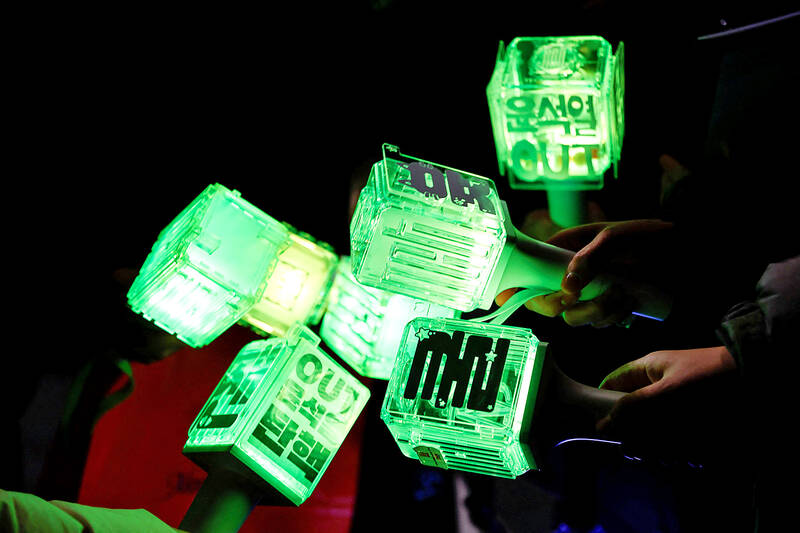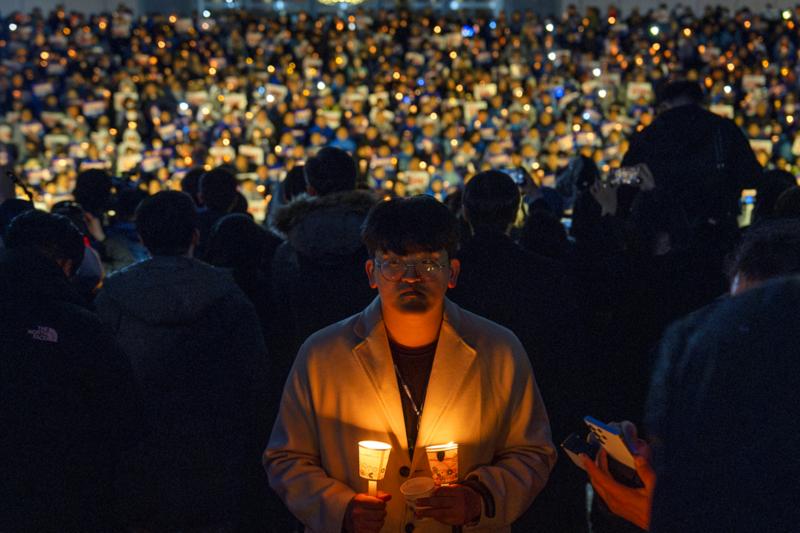While South Korean protesters have long employed songs, dances and chants, customized light sticks popular with K-pop fans have emerged as an effective new tool for demonstrators calling for the impeachment of President Yoon Suk-yeol.
Tens of thousands of protesters have braved near sub-zero temperatures and gathered outside the National Assembly in the capital of Seoul since Yoon’s failed martial law attempt last week.
“Impeach, impeach. Impeach Yoon Suk-yeol,” protesters chanted to the beat of K-pop group aespa’s latest techno track Whiplash.

Photo: Reuters
Videos of synchronized chanting and light stick movements in unison at the protests have gone viral on social media along with flags carrying messages and memes from mainly younger demonstrators.
“Give us geeks the freedom to only worry about geek things,” one meme flag carried on a flagpole at Saturday’s protest read, capturing the mood among young people amid deepening political turmoil.
One of the advantages of the light sticks is how sturdy they are, said Kim Do-heon, a Seoul-based music critic.

Photo: AP
“It also shines very bright and comes in a size that is easy to carry around.”
South Koreans are playing the long game, said Shin Jae-yun who came out to protest against Yoon with a light stick for K-pop boy band TREASURE, because protests are a “very painful act” yet there is no guarantee things will improve right away.
“To endure such pain, you have to have something to enjoy in it so that people can stay hopeful for a long time even when it drags on,” Shin said.
Playlists of popular K-pop protest songs are also being shared on X. Kim Byung-joo, a lawmaker from the main opposition Democratic Party, jumped on the trend on Monday and posted a playlist on the platform: “Impeach Yoon Suk-yeol, ringleader of treason!...from folk songs to K-pop.”
South Korea has a rich history of protest since democracy took root in the 1980s after a series of military interventions. Demonstrations over worker rights, threats from neighboring North Korea and perceived government failings have sometimes turned violent in the past.
Lee Seul-gi, a 36-year-old woman who is a fan of K-pop boyband ATEEZ, said the impeachment protests this time around have become more accessible.
“Previous rallies might have been a bit violent and scary. But the light sticks and K-pop have lowered the barrier,” Lee said.
CANDLE UPGRADE
Until 2016, candles were prominent at many protests and played a central role in the rallies that led to the impeachment of former President Park Geun-hye.
Park was ousted over a graft scandal and was later jailed over the scandal that exposed webs of corruption between political leaders and the country’s conglomerates.
“So many people were holding candles, putting paper cups over them and carrying them out so they wouldn’t go out. But now the age of the light sticks is here, not candles,” music critic Kim said.
Stephanie Choi, a researcher at the State University of New York at Buffalo, said the light sticks still reflect the “power of solidarity while maintaining the original meaning of non-violence.”
While men and women from all age groups are gathering and calling on parliament to impeach Yoon, young women are outnumbering their male peers at the protests.
Yoon vowed to abolish the gender equality ministry before taking office and was an unpopular candidate with women voters in their 20s in the 2022 presidential election.
He won office in 2022 by the slimmest margin in South Korean history but his party suffered a landslide defeat in parliamentary elections earlier this year.
The K-pop industry is notoriously apolitical and so are the lyrics of many K-pop songs playing at the impeachment protests. In South Korea, celebrities expressing political opinions are often frowned upon.
But experts say fans are conscious of K-pop’s power and the underlying messages of female empowerment it carries.
“K-pop is a female-dominant space...and their feminist demands have shaped K-pop’s aesthetics and performances today,” Choi said.
Kim Da-in, a 19-year-old fan of virtual idol group Plave, said the impeachment protests are uniting all K-pop fandoms.
“Here, I feel that we are citizens of South Korea first before we are idol fans.”

The canonical shot of an East Asian city is a night skyline studded with towering apartment and office buildings, bright with neon and plastic signage, a landscape of energy and modernity. Another classic image is the same city seen from above, in which identical apartment towers march across the city, spilling out over nearby geography, like stylized soldiers colonizing new territory in a board game. Densely populated dynamic conurbations of money, technological innovation and convenience, it is hard to see the cities of East Asia as what they truly are: necropolises. Why is this? The East Asian development model, with

Desperate dads meet in car parks to exchange packets; exhausted parents slip it into their kids’ drinks; families wait months for prescriptions buy it “off label.” But is it worth the risk? “The first time I gave him a gummy, I thought, ‘Oh my God, have I killed him?’ He just passed out in front of the TV. That never happens.” Jen remembers giving her son, David, six, melatonin to help him sleep. She got them from a friend, a pediatrician who gave them to her own child. “It was sort of hilarious. She had half a tub of gummies,

The wide-screen spectacle of Formula One gets a gleaming, rip-roaring workout in Joseph Kosinski’s F1, a fine-tuned machine of a movie that, in its most riveting racing scenes, approaches a kind of high-speed splendor. Kosinski, who last endeavored to put moviegoers in the seat of a fighter jet in Top Gun: Maverick, has moved to the open cockpits of Formula One with much the same affection, if not outright need, for speed. A lot of the same team is back. Jerry Bruckheimer produces. Ehren Kruger, a co-writer on Maverick, takes sole credit here. Hans Zimmer, a co-composer previously, supplies the thumping

No more elephant and monkey acts. No more death-defying motorbike stunts. No more singing or acting on stage. Several hundred spectators still clapped constantly when acrobats with Dongchoon Circus Troupe, South Korea’s last and 100-year-old circus, twirled on a long suspended fabric, juggled clubs on a large, rotating wheel and rode a unicycle on a tightrope under the big top. “As I recall the hardship that I’ve gone through, I think I’ve done something significant,” Park Sae-hwan, the head of the circus, said in a recent interview. “But I also feel heavy responsibility because if Dongchoon stops, our country’s circus, one genre